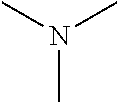Hyrophilic ethylene oxide free emulsifier comprising dendrimeric polyhydroxylated ester moieties
- Summary
- Abstract
- Description
- Claims
- Application Information
AI Technical Summary
Benefits of technology
Problems solved by technology
Method used
Image
Examples
Example
[0312]Based on the reaction described in example 1a) a dimer was synthesized which contains one ester bond.
[0313]The material was cooled down to room temperature after the oligomerization. The candy like material was mixed with propylene glycol monomethylether and the mixture homogenized in the refluxing solvent (aprox. 120° C.). A 46.9% active dispersion of the dimer in propylene glycol monomethylether was obtained.
Preparation of Intermediate Material 5
Oligomerization of 2,2-bis-(hydroxymethyl) propionic acid-pentamer
Example
[0314]Based on the reaction described in example 1 a pentamer was synthesized which contains four ester bonds
with
R18═H or
[0315]
[0316]The material was cooled down to room temperature after the oligomerization.
[0317]The candy like material was mixed with propylene glycol monomethylether and the mixture homogenized in the refluxing solvent (aprox. 120° C.). A 48.2% active dispersion of the pentamer in propylene glycol monomethylether was obtained.
Comparative Examples 1-2
Example
Comparative Example 1
Production of a Copolymer Comprising Lactic Acid Ester Units
[0318]19.6 g (217.1 mmol) DL-lactic acid, 0.45 g triethyl amine and 70 g (211 mmol epoxy groups) of a siloxane of the structure
were dissolved in 38.4 g propylene glycol monomethylether. The mixture was heated to 120° C. for 10 hours. The epoxide conversion is determined by means of NMR (99.3%).
[0319]Afterwards, 80 g water were added. The azeotrope water / propylene glycol monomethylether and some excess water were distilled off at approximately 95° C. to finally 100° C.
[0320]A transparent solution of the target polymer in water having an active level of 90.6% was obtained.
[0321]The approximate structure is
PUM
| Property | Measurement | Unit |
|---|---|---|
| Temperature | aaaaa | aaaaa |
| Fraction | aaaaa | aaaaa |
| Molar ratio | aaaaa | aaaaa |
Abstract
Description
Claims
Application Information
 Login to View More
Login to View More - R&D
- Intellectual Property
- Life Sciences
- Materials
- Tech Scout
- Unparalleled Data Quality
- Higher Quality Content
- 60% Fewer Hallucinations
Browse by: Latest US Patents, China's latest patents, Technical Efficacy Thesaurus, Application Domain, Technology Topic, Popular Technical Reports.
© 2025 PatSnap. All rights reserved.Legal|Privacy policy|Modern Slavery Act Transparency Statement|Sitemap|About US| Contact US: help@patsnap.com



